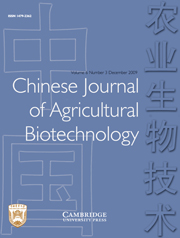Article contents
Characterization and heterologous expression of testosterone-inducible regulator from Comamonas testosteroni in Escherichia coli
Published online by Cambridge University Press: 24 April 2009
Abstract
The testosterone-inducible regulator (teiR) gene was cloned from Comamonas testosteroni chromosomal DNA, and introduced into plasmids pKtac2 (containing a tac promoter) and pK18 to yield plasmids pKtac2-teiR and pKteiR100. The recombinant plasmids were transformed into competent Escherichia coli HB101 and total protein was extracted to detect the TeiR protein expression level using enzyme-linked immunosorbent assay (ELISA). E. coli transformed by pKtac2-teiR and pKteiR100 produced 6.65 and 5.93 μg/mg of TeiR protein, respectively. Recombinant plasmids were also co-transformed into competent E. coli HB101 with plasmid p6 [containing hsdA gene (3α-HSD/CR, 3α-hydroxysteroid dehydrogenase/carbonyl reductase encoding gene)] to reveal the relationship between 3α-HSD/CR and TeiR by ELISA. The amounts of TeiR protein expressed by E. coli containing pKtac2-teiR and pKteiR100 were 5.94 μg/mg and 5.33 μg/mg, respectively, and these increased up to 6.81 μg/mg and 6.10 μg/mg after inducing with 1 mmol/l isopropyl-β-d-thiogalactoside (IPTG). Interestingly, 3α-HSD/CR protein expression level, after co-transformation with plasmids pKtac2-teiR and p6, was lower than that observed in the co-transformation with pKteiR100 and p6. The first co-transformation induced 1.20 μg/mg 3α-HSD/CR protein and the second 1.71 μg/mg. These values rose to 1.42 and 1.80 μg/mg, respectively, after treatment with 1 mmol/l IPTG. Our results proved that the tac promoter was more efficient than the lacZ promoter and that the teiR gene could act as an activator for hsdA gene expression.
Keywords
- Type
- Research Papers
- Information
- Copyright
- Copyright © China Agricultural University 2009
References
- 1
- Cited by


